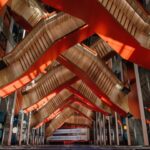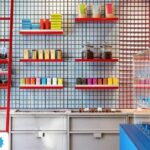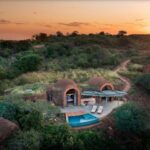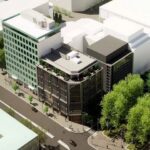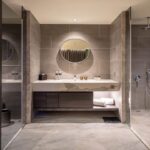New regulations for wet area proofing
Changes in the National Construction Code (NCC) have produced new provisions relating to waterproofing wet areas, particularly as they relate to residential applications.
KBDi, Australia’s kitchen and bathroom authority, shares an overview of the defining terms of the new ABCB Housing Provisions standard.

GALLERY
The National Construction Code (NCC) Volume 2 sets out the following ‘Deemed-to-Satisfy Provisions’ for Class 1 dwellings:
Compliance with AS 3740 or Part 10.2 of the ABCB Housing Provisions satisfies Performance Requirement H4P1 for wet areas, provided the wet areas are protected in accordance with the appropriate requirements of 10.2.1 to 10.2.6 and 10.2.12 of the ABCB Housing Provisions.

I Love Amsterdam Suite
The ABCB Housing Provisions determines that building elements in wet areas within a building must be protected with a waterproofing system. This system must be either waterproof or water-resistant in accordance with clauses 10.2.2 to 10.2.6.
Note for SA Members South Australia has state variations related to the opening clause (10.2.1 Wet Areas). Don’t hesitate to get in touch with our office to learn more.
What’s the difference between ‘waterproof’ and ‘water resistant’?
Waterproof means the property of a material that does not allow moisture to penetrate through it. The following materials used in waterproofing systems are deemed to be waterproof:
- Stainless steel
- Flexible waterproof sheet flooring material with waterproof joints
- Membranes complying with AS/NZS 4858 and
- Waterproof sealant
Water Resistant means the property of a system or material that restricts moisture movement and will not degrade under conditions of moisture.
Typically, a wet area surface will consist of a water-resistant surface installed over a water-resistant substrate. Types of water-resistant substrates include:
WALLS
- Concrete complying with AS 3600, treated to resist moisture movement.
- Cement render, treated to resist moisture movement
- Compressed fibre-cement sheeting manufactured in accordance with AS/NZS 2908.2
- Water-resistant plasterboard sheeting
- Masonry in accordance with AS 3700, treated to resist moisture movement

Baia bathroom auroom
FLOORS
- Concrete complying with AS 3600
- Concrete slabs complying with AS 2870
- Compressed fibre-cement sheeting manufactured in accordance with AS/NZS 2908.2 and supported on a structural floor
Water-resistant surface materials include:
WALLS
- Thermosetting laminate
- Pre-decorated compressed fibre-cement sheeting manufactured in accordance with AS/NZS 2908.2
- Tiles, when used in conjunction with a substrate listed above
- Water-resistant flexible sheet wall material with sealed joints when used in conjunction with a substrate listed above
- Sanitary-grade acrylic linings
FLOORS (when used in conjunction with a substrate listed above)
- Tiles
- Water-resistant flexible sheet flooring material with sealed joints
- Concrete treated to resist moisture movement
Prior to the NCC 2022 update, the Code indicated that shower walls should be water-resistant. It should be noted that the revisions now stipulate that the shower area walls must be waterproof not less than 1800 mm above the floor substrate.
With respect to Shower Areas, the Housing Provisions document sets out the following.
For a shower area with a hob, step-down or level threshold, the following applies:
- the floor of the shower area must be waterproof, including any hob or step-down.
- the walls of the shower area must be waterproof not less than 1800 mm above the floor substrate.
- wall junctions and joints within the shower area must be waterproof not less than 40 mm either side of the junction.
- wall/floor junctions within the shower area must be waterproof.
- penetrations within the shower area must be waterproof.
A shower with a preformed shower base must comply with (b) to (e) above.
Where a shower is located above a bath or spa, the requirements for a shower should be used.
For more information, visit kbdimembers.com.au
A striking red staircase has become the symbolic thread connecting two NAB workplaces located 24 kilometres apart, with ...
A new boutique for Les Chocolats de Chloé has brought a burst of colour and childhood wonder to ...
Domed timber roofs, stone cladding and an emphasis on natural materials define Suyian Lodge, a new safari resort ...
Morris Property Group has lodged an application to consolidate three neighbouring commercial sites in the heart of Canberra, ...
The guest bathrooms at Park Lees Hotel in Kaohsiung are defined by a warm, natural aesthetic thanks to ...







